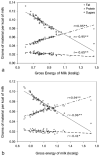Rhesus macaque milk: magnitude, sources, and consequences of individual variation over lactation
- PMID: 18711734
- PMCID: PMC2615798
- DOI: 10.1002/ajpa.20911
Rhesus macaque milk: magnitude, sources, and consequences of individual variation over lactation
Abstract
Lactation represents the greatest postnatal energetic expenditure for mammalian mothers, and a mother's ability to sustain the costs of lactation is influenced by her physical condition. Mothers in good condition may produce infants who weigh more, grow faster, and are more likely to survive than the infants of mothers in poor condition. These effects may be partially mediated through the quantity and quality of milk that mothers produce during lactation. However, we know relatively little about the relationships between maternal condition, milk composition, milk yield, and infant outcomes. Here, we present the first systematic investigation of the magnitude, sources, and consequences of individual variation in milk for an Old World monkey. Rhesus macaques produce dilute milk typical of the primate order, but there was substantial variation among mothers in the composition and amount of milk they produced and thus in the milk energy available to infants. Relative milk yield value (MYV), the grams of milk obtained by mammary evacuation after 3.5-4 h of maternal-infant separation, increased with maternal parity and was positively associated with infant weight. Both milk gross energy (GE) and MYV increased during lactation as infants aged. There was, however, a trade-off; those mothers with greater increases in GE had smaller increases in MYV, and their infants grew more slowly. These results from a well-fed captive population demonstrate that differences between mothers can have important implications for milk synthesis and infant outcome.
2008 Wiley-Liss, Inc.
Figures



References
-
- Akaike H. A new look at the statistical model identification. IEEE Trans Automat Control. 1974;19:716–723.
-
- Akers RM. Lactation and the mammary gland. Iowa: Blackwell Publishing; 2002.
-
- Altmann J, Alberts SC. Growth rates in a wild primate population: ecological influences and maternal effects. Behav Ecol Sociobiol. 2005;57:490–501.
-
- Bercovitch FB, Widdig A, Nürnberg P. Maternal investment in rhesus macaques (Macaca mulatta) reproductive costs and consequences of raising sons. Behav Ecol Sociobiol. 2000;48:1–11.
-
- Bernhart FW. Correlation between growth-rate of the suckling of various species and the percentage of total calories from protein in the milk. Nature. 1961;191:358–360.
Publication types
MeSH terms
Grants and funding
LinkOut - more resources
Full Text Sources

